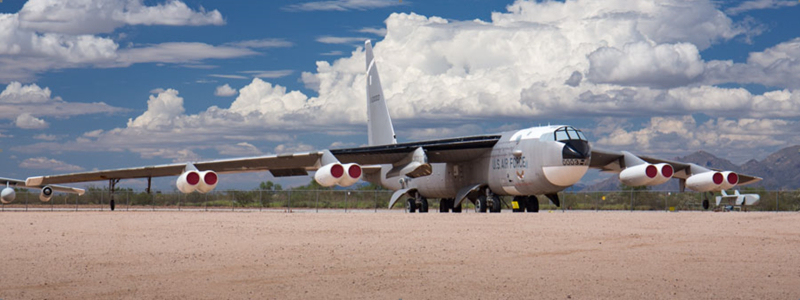History Deep-Sixed
Today, a fragment of history quietly disappears. The University of Houston presents this series about the machines that make our civilization run, and the people whose ingenuity created them.
______________________
I’ve often wondered about so much history that’s incomplete – or even absent. So much we don’t know about Troy, the Roanoke Colony – Amelia Earhart’s end. Some history vanishes by chance. But here’s a personal story – a small thing, to be sure – but one that shows how history might be made to vanish.
It’s 1951: I’m just out of college and at work on Boeing’s new B-52A bomber. I’m in what they call the pneumatics group. You see, airplanes use electricity to operate things like hydraulic pumps, control actuators and such.

The only surviving Boeing B-52A at the Pima Air and Space Museum
But Boeing was trying a radical new idea. Instead of wiring, they bled high-pressure air from the jet engine compressors. Then they piped it throughout the airplane. That air drove small turbines to power the airplane’s mechanical systems.
So here I was, designing brackets to hang those ducts. The idea didn’t seem quite right. But who was I to question! Then – a warning shot: A duct exploded in the prototype’s wing during a taxi test. But Boeing was committed!
So we kept working on the production model – my 52A. I was proud of one design – a complex exhaust duct for the turbine that moved the ailerons. Still, I wearied of working on bombers. I left. I went back to graduate school.
Then, years later, I wondered: Had my exhaust design ever flown? I found that Boeing went back to engine-driven electricity in the B-52F. That was shortly before the airplane saw combat – carpet-bombing in Vietnam.
But maybe I could still find a way to see an old 52A. And there the plot thickens! Boeing had planned to make thirteen of them. But, in the end, they made only three! And those served only as test platforms.
It seemed, as I searched, that as far as history went, the pneumatic idea had almost never happened. One exhaustive history of the airplane gives only a paragraph to the prototype explosion – no further mention of pneumatics. And only four paragraphs about the 52A.

This documentary History makes no mention of pneumatic systems in production models.
Finally, I found an online magazine, AirVectors. That’s where I learned that Boeing had finally dumped its unreliable pneumatic system. It appears to’ve been an embarrassment. Something that Boeing quietly set aside.
The history of events, both large and small, is at the mercy of many things – deteriorating documents and other ravages of time. Or the focus of people who write history. And, when those of us who worked on that pneumatic experiment are gone, one can only wonder: How consciously did Boeing erase a failed experiment from its own history?
I’m John Lienhard, at the University of Houston, where we’re interested in the way inventive minds work.
(Theme Music)
The B-52 Wikipedia page mentions only the pneumatic system explosion on the XB-52. It makes no mention of its staying in use until the B-52F.
After much searching, I finally found the following online article. It confirms that the pneumatic, or bleed-air system lasted throughout the B52E, and was finally replaced with an electric system in the B-52F. [1.0] B-52 Evolution
See also, Walter J. Boyne: Boeing B-52, A Documentary History, Schiffer Publishing Ltd., 1994. This is the exhaustive book that I mentioned – the one that devotes four paragraphs to the first production model – the B-52A – and one paragraph to the pneumatic system on the prototype XB-52. And it mentions the latter, only since it had to mention the explosion. And the word does not appear again, nor it is indexed.
The Pima Air & Space Museum houses the one surviving B-52A See: Boeing B-52A - Pima Air & Space
I am grateful to aerial historian Tom Callen for his counsel and to the Pima Air Museum archivest, Andrew Boehly, for further information about the last surviving B-52A. In particular, he found a manual for the airplane. It made brief mention of its pneumatic system.
This Episode first aired on June 16, 2025.